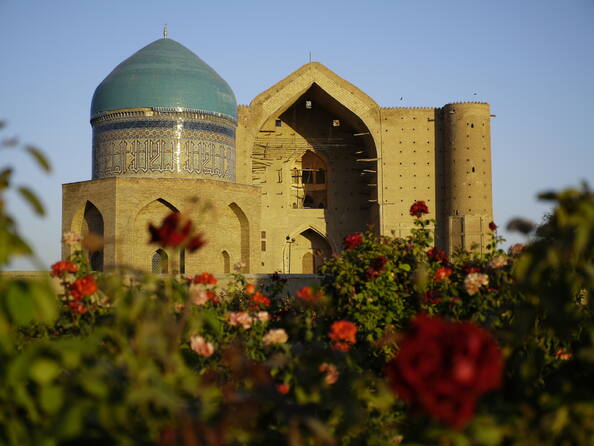Мавзолей Ходжи Ахмеда Яссави (город Туркестан)
Mausoleum of Khoja Ahmed Yasawi
The Mausoleum of Khoja Ahmed Yasawi, in the town of Yasi, now Turkestan, was built at the time of Timur (Tamerlane), from 1389 to 1405. In this partly unfinished building, Persian master builders experimented with architectural and structural solutions later used in the construction of Samarkand, the capital of the Timurid Empire. Today, it is one of the largest and best-preserved constructions of the Timurid period.
Description is available under license CC-BY-SA IGO 3.0
Mausolée de Khoja Ahmad Yasawi
Le mausolée de Khoja Ahmad Yasawi, dans la ville de Yasi, aujourd’hui appelée Turkestan, fut construit à l’époque de Tamerlan, de 1389 à 1405. Dans ce bâtiment, dont certaines parties demeurèrent inachevées, les maîtres constructeurs perses expérimentèrent de nouvelles solutions architecturales et structurelles qui furent ensuite adoptées pour la construction de Samarkand, capitale de l’Empire timuride. C’est aujourd’hui l’une des constructions les plus grandes et les mieux conservées de l’époque timuride.
Description is available under license CC-BY-SA IGO 3.0
ضريح الخوجه أحمد يسوي
تمّ إنشاء ضريح الخوجه أحمد يسوي في مدينة ياسي المعروفة اليوم باسم تركستان في عهد تيمورلنك من 1389 حتى 1405. في هذا المبنى حيث لا يزال بعض الأجزاء منه غير منتهية، اختبر المهندسون الفرس تجارب هندسيّةً و بنيويّةً جديدةً تمّ اعتمادها في ما بعد لبناء سمرقند عاصمة الامبراطوريّة التيموريّة. وهو الآن من أكبر المباني المتبقيّة من العصر التيموري وتتمّ المُحافظة عليه بأفضل الطرق.
source: UNESCO/CPE
Description is available under license CC-BY-SA IGO 3.0
霍贾•艾哈迈德•亚萨维陵墓
霍贾·艾哈迈德·亚萨维陵墓,位于突厥斯坦(以前称为亚瑟市),建造于帖木儿时期,即公元1389年至1405年。就是从这座未完工的建筑中,波斯高明的建筑者们试验了各种建筑方法,后来使用到了帖木儿王国都城撒马尔罕的建造中。今天,霍贾·艾哈迈德·亚萨维陵墓成为了帖木儿时期规模最大、保存最完整的建筑之一。
source: UNESCO/CPE
Description is available under license CC-BY-SA IGO 3.0
Мавзолей Ходжи Ахмеда Яссави (город Туркестан)
Мавзолей Ходжи Ахмеда Яссави в городе Ясы (ныне Туркестан) был построен в период правления Тимура (Тамерлана) в конце XIV-начале XV вв. При сооружении этого не совсем законченного здания персидские зодчие применяли ряд новаторских архитектурных и строительных решений, которые были использованы также при возведении Самарканда, столицы империи Тимуридов. Сегодня мавзолей является одним из самых значительных и хорошо сохранившихся сооружений той эпохи.
source: UNESCO/CPE
Description is available under license CC-BY-SA IGO 3.0
Mausoleo de Khoja Ahmad Yasawi
Este mausoleo está situado en la ciudad de Yasi, hoy denominada Turkestán, y fue construido entre 1389 y 1405, en tiempos de Tamerlán. En este edificio, que quedó inconcluso en parte, los maestros de obras persas experimentaron nuevas soluciones estructurales y arquitectónicas que se utilizarían posteriormente en la construcción de Samarcanda, la capital del Imperio Timúrida. Es una de las construcciones más monumentales y mejor conservadas de la época timúrida.
source: UNESCO/CPE
Description is available under license CC-BY-SA IGO 3.0
ホンジャ・アフメッド・ヤサウイ廟
source: NFUAJ
Mausoleum van Khoja Ahmed Yasawi
Het mausoleum van Khoja Ahmed Yasawi ligt in de stad Yasi (nu Turkestan) in het zuiden van Kazachstan. Het werd van 1389 tot 1405 gebouwd in opdracht van de heerser van Centraal-Azië Timur (Tamerlan). In dit deels onvoltooide gebouw hebben Perzische bouwmeesters geëxperimenteerd met architecturale en structurele oplossingen die later werden gebruikt in de bouw van Samarkand, de hoofdstad van de Timuride dynastie. Het mausoleum geldt tegenwoordig als een van de grootste en best bewaarde constructies uit de Timuride periode. Het multifunctionele mausoleum is gebouwd van gebakken steen en bevat vijfendertig kamers met verschillende functies.
Source: unesco.nl
